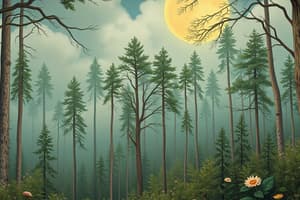Podcast
Questions and Answers
What is the main characteristic of boreal forests?
What is the main characteristic of boreal forests?
- Rich in biodiversity
- Thick and lush canopy
- Tropical climate
- Presence of coniferous species (correct)
Where are boreal forests mainly located?
Where are boreal forests mainly located?
- Northern latitudes in North America, Siberia, Scandinavia, Alaska, Canada, Mexico (correct)
- Equatorial Africa
- Southern Europe
- Tropical regions
What is the length of the growing season in boreal forests per year?
What is the length of the growing season in boreal forests per year?
- 365 days
- 130 days (correct)
- Around 200 days
- Less than 50 days
Which of the following is characteristic of boreal forest climates?
Which of the following is characteristic of boreal forest climates?
Why does the understory in boreal forests tend to be limited?
Why does the understory in boreal forests tend to be limited?
Which type of forest biome has precipitation concentrated in the winter and less than 1000 mm per year?
Which type of forest biome has precipitation concentrated in the winter and less than 1000 mm per year?
What type of leaves do the conifers in boreal forests typically have?
What type of leaves do the conifers in boreal forests typically have?
What characterizes the flora of the temperate forest biome?
What characterizes the flora of the temperate forest biome?
Which animal is NOT typically found in the temperate forest biome?
Which animal is NOT typically found in the temperate forest biome?
What distinguishes the canopy of a temperate forest biome?
What distinguishes the canopy of a temperate forest biome?
Which forest subdivision has mild winters and high annual precipitation (greater than 200 cm)?
Which forest subdivision has mild winters and high annual precipitation (greater than 200 cm)?
What is a common feature of the soil in the temperate forest biome?
What is a common feature of the soil in the temperate forest biome?
What is a defining characteristic of temperate broad-leaved rainforests?
What is a defining characteristic of temperate broad-leaved rainforests?
Which of the following tree species is not a part of the principal forest genera of temperate forests?
Which of the following tree species is not a part of the principal forest genera of temperate forests?
What is a significant difference between temperate forests and tropical forests based on the text?
What is a significant difference between temperate forests and tropical forests based on the text?
What is a key factor influencing the existence of forests in tropical regions?
What is a key factor influencing the existence of forests in tropical regions?
Which type of forest has mean annual temperatures ranging from 22°C to 28°C?
Which type of forest has mean annual temperatures ranging from 22°C to 28°C?
What is a common characteristic of the soil in tropical forests?
What is a common characteristic of the soil in tropical forests?
Flashcards are hidden until you start studying
Study Notes
Major Forest Biomes
- Boreal forest (Coniferous/Taiga) covers northern latitudes in North America, Siberia, Scandinavia, Alaska, Canada, Mexico, Nordic countries, and the former USSR.
- Provides 20% of the world's industrial wood raw materials.
Characteristics of Boreal Forest
- Occurs between polar forest (northern tundra) and temperate mixed forests of the south and at high altitudes in the temperate zone.
- Short, moist, and moderately warm summers (duration not longer than four months).
- Long, cold, and dry winters with temperatures very low (annual mean -5°C to +5°C).
- Precipitation is primarily in the form of snow (mean annual 400-1000 mm).
- Soil is thin, nutrient-poor, and acidic.
- Canopy permits low light penetration, resulting in limited understory.
- Flora consists mostly of cold-tolerant evergreen conifers with needle-like leaves.
Temperate Forest
- Temperature varies from -30°C to 30°C (annual mean +5°C to +15°C).
- Precipitation (500-2000 mm) is distributed evenly throughout the year.
- Soil is fertile, enriched with decaying litter.
- Canopy is moderately dense, allowing light to penetrate, resulting in well-developed and richly diversified understory vegetation and stratification of animals.
- Flora is characterized by 3-4 tree species per square kilometer, with broad leaves that are lost annually.
- Fauna includes squirrels, rabbits, skunks, birds, deer, mountain lion, bobcat, timber wolf, fox, and black bear.
Subdivisions of Temperate Forest
- Moist conifer and evergreen broad-leaved forests: wet winters and dry summers.
- Dry conifer forests: dominate higher elevation zones; low precipitation.
- Mediterranean forests: precipitation is concentrated in winter, less than 1000 mm per year.
- Temperate coniferous: mild winters, high annual precipitation (greater than 200 cm).
- Temperate broad-leaved rainforests: mild, frost-free winters, high precipitation (more than 150 cm) evenly distributed throughout the year.
Tropical Forest
- Covers regions near the equator (latitudes 23.5°N and 23.5°S).
- Existence of forests strongly depends on precipitation and its distribution.
- Mean annual temperature is from 22°C to 28°C (varies little throughout the year).
- Temperature of the coldest month is more than +18°C.
- Precipitation is evenly distributed throughout the year, with annual rainfall exceeding 2000 mm.
- Soil is nutrient-poor and acidic.
Studying That Suits You
Use AI to generate personalized quizzes and flashcards to suit your learning preferences.




